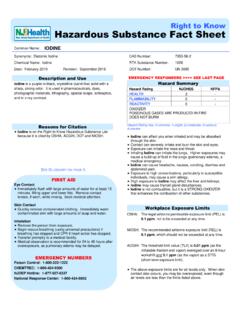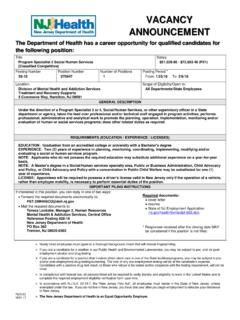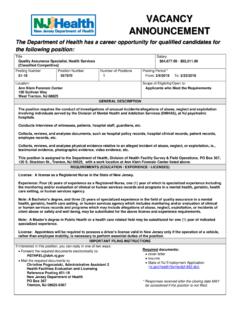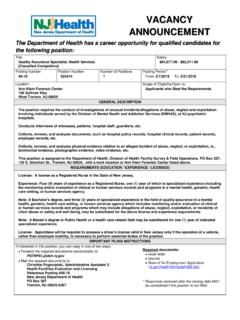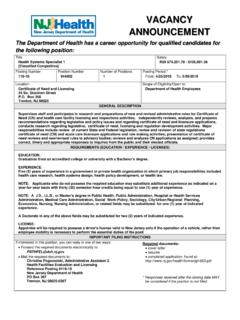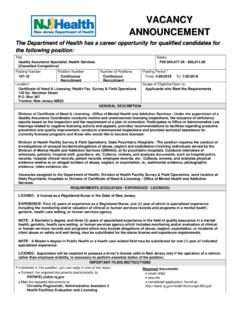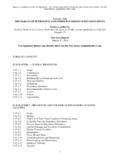Transcription of Right to Know Hazardous Substance Fact Sheet
1 Right to Know Hazardous Substance Fact Sheet Common Name: POTASSIUM HYDROXIDE Synonyms: Caustic Potash; Lye; Potassium Hydrate Chemical Name: Potassium Hydroxide (KOH) Date: May 2001 Revision: January 2010 CAS Number: 1310-58-3 RTK Substance Number: 1571 DOT Number: UN 1813 Description and Use Potassium Hydroxide is an odorless, white or slightly yellow, flakey or lumpy solid which is often in a water solution. It is used in making soap, as an electrolyte in alkaline batteries and in electroplating, lithography, and paint and varnish removers. Liquid drain cleaners contain 25 to 36% of Potassium Hydroxide.
2 Reasons for Citation f Potassium Hydroxide is on the Right to Know Hazardous Substance List because it is cited by ACGIH, DOT, NIOSH, NFPA and EPA. f This chemical is on the Special Health Hazard Substance List. SEE GLOSSARY ON PAGE 5. FIRST AID Eye Contact f Quickly brush off excess chemical from the face. Immediately flush with large amounts of water for at least 30 minutes, lifting upper and lower lids. Remove contact lenses, if worn, while flushing. Seek medical attention immediately. Skin Contact f Quickly remove contaminated clothing. Immediately blot or brush off excess chemical and wash gently with large amounts of soap and water for at least 30 minutes.
3 Seek medical attention immediately. Inhalation f Remove the person from exposure. f Begin rescue breathing (using universal precautions) if breathing has stopped and CPR if heart action has stopped. f Transfer promptly to a medical facility. f Medical observation is recommended for 24 to 48 hours after overexposure, as pulmonary edema may be delayed. EMERGENCY NUMBERS Poison Control: 1-800-222-1222 CHEMTREC: 1-800-424-9300 NJDEP Hotline: 1-877-927-6337 National Response Center: 1-800-424-8802 EMERGENCY RESPONDERS >>>> SEE LAST PAGE Hazard Summary Hazard Rating NJDOH NFPA HEALTH - 3 FLAMMABILITY - 0 REACTIVITY - 1 CORROSIVE POISONOUS GASES ARE PRODUCED IN FIRE DOES NOT BURN Hazard Rating Key: 0=minimal; 1=slight; 2=moderate; 3=serious.
4 4=severe f Potassium Hydroxide can affect you when inhaled and by passing through the skin. f Potassium Hydroxide is a HIGHLY CORROSIVE CHEMICAL and contact can severely irritate and burn the skin and eyes leading to eye damage. f Contact can irritate the nose and throat. f Inhaling Potassium Hydroxide can irritate the lungs. Higher exposures may cause a build-up of fluid in the lungs (pulmonary edema), a medical emergency. f Exposure to Potassium Hydroxide can cause headache, dizziness, nausea and vomiting. f Potassium Hydroxide may cause a skin allergy. Workplace Exposure Limits NIOSH: The recommended airborne exposure limit (REL) is 2 mg/m3, which should not be exceeded at any time.
5 ACGIH: The threshold limit value (TLV) is 2 mg/m3, which should not be exceeded at any time. f The above exposure limits are for air levels only. When skin contact also occurs, you may be overexposed, even though air levels are less than the limits listed above. POTASSIUM HYDROXIDE Page 2 of 6 Determining Your Exposure f Read the product manufacturer s material safety data Sheet ( msds ) and the label to determine product ingredients and important safety and health information about the product mixture. f For each individual Hazardous ingredient, read the New Jersey Department of Health Hazardous Substance Fact Sheet , available on the RTK website ( ) or in your facility s RTK Central File or Hazard Communication Standard file.
6 F You have a Right to this information under the New Jersey Worker and Community Right to Know Act and the Public Employees Occupational safety and Health (PEOSH) Act if you are a public worker in New Jersey, and under the federal Occupational safety and Health Act (OSHA) if you are a private worker. f The New Jersey Right to Know Act requires most employers to label chemicals in the workplace and requires public employers to provide their employees with information concerning chemical hazards and controls. The federal OSHA Hazard Communication Standard (29 CFR ) and the PEOSH Hazard Communication Standard ( 12:100-7) require employers to provide similar information and training to their employees.
7 This Fact Sheet is a summary of available information regarding the health hazards that may result from exposure. Duration of exposure, concentration of the Substance and other factors will affect your susceptibility to any of the potential effects described below. Health Hazard Information Acute Health Effects The following acute (short-term) health effects may occur immediately or shortly after exposure to Potassium Hydroxide: f Contact can severely irritate and burn the skin and eyes with possible eye damage. f Contact can irritate the nose and throat. f Inhaling Potassium Hydroxide can irritate the lungs causing coughing and/or shortness of breath.
8 Higher exposures may cause a build-up of fluid in the lungs (pulmonary edema), a medical emergency, with severe shortness of breath. f Exposure to Potassium Hydroxide can cause headache, dizziness, nausea and vomiting. Chronic Health Effects The following chronic (long-term) health effects can occur at some time after exposure to Potassium Hydroxide and can last for months or years: Cancer Hazard f According to the information presently available to the New Jersey Department of Health, Potassium Hydroxide has not been tested for its ability to cause cancer in animals. Rproductive Hazard f According to the information presently available to the New Jersey Department of Health, Potassium Hydroxide has not been tested for its ability to affect reproduction.
9 Other Effects f Potassium Hydroxide can irritate the lungs. Repeated exposure may cause bronchitis to develop with coughing, phlegm, and/or shortness of breath. f Skin allergy may occur with itching, redness and/or an rash. If allergy develops, very low future exposure can trigger symptoms. Medical Medical Testing Before beginning employment and at regular times thereafter, (at least annually), the following are recommended: f Lung function tests If symptoms develop or overexposure is suspected, the following are recommended: f Consider chest x-ray after acute overexposure f Evaluation by a qualified allergist can help diagnose skin allergy.
10 F Exam of the eyes and vision Any evaluation should include a careful history of past and present symptoms with an exam. Medical tests that look for damage already done are not a substitute for controlling exposure. Request copies of your medical testing. You have a legal Right to this information under the OSHA Access to Employee Exposure and Medical Records Standard (29 CFR ). Mixed Exposures f Smoking can cause heart disease, lung cancer, emphysema, and other respiratory problems. It may worsen respiratory conditions caused by chemical exposure. Even if you have smoked for a long time, stopping now will reduce your risk of developing health problems.
